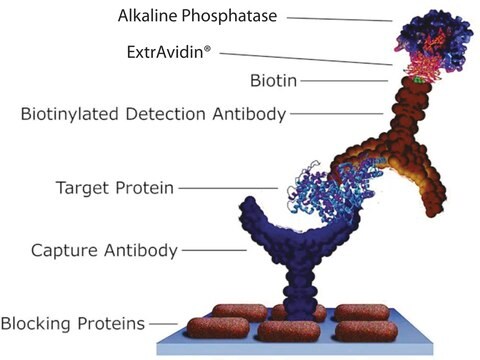おすすめの製品
由来生物
mouse
品質水準
抗体製品の状態
purified antibody
抗体製品タイプ
secondary antibodies
クローン
HP6069, monoclonal
フォーム
liquid
含まれません
preservative
メーカー/製品名
Calbiochem®
保管条件
OK to freeze
avoid repeated freeze/thaw cycles
アイソタイプ
IgG
輸送温度
ambient
保管温度
−20°C
ターゲットの翻訳後修飾
unmodified
関連するカテゴリー
詳細
Purified mouse monoclonal antibody conjugated to biotin. Recognizes human IgG1 Fc fragment.
This Mouse Anti-Human IgG₁, Fc Fragment Specific (HP6069) Biotin Conjugate is validated for use in Enzyme Immunoassay for the detection of Human IgG₁, Fc Fragment Specific.
アプリケーション
Enzyme Immunoassay (1:500-1:2000)
包装
Please refer to vial label for lot-specific concentration.
警告
Toxicity: Standard Handling (A)
その他情報
Antibody should be titrated for optimal results in individual systems.
Cross-reactivity by ELISA against human myeloma proteins:
Human IgG1: 100%
Human IgG2: ≤0.1%
Human IgG3: ≤0.2%
Human IgG4: ≤0.1%
Human IgM: ≤0.1%
Human IgA: ≤0.1%
Human IgE: ≤0.1%
Cross-reactivity by ELISA against chimeric antibodies:
Human IgG1: 100%
Human IgG2: <0.02%
Human IgG3: <0.02%
Human IgG4: <0.02%
Human IgM: <0.02%
Human IgA: <0.01%
Human IgE: <0.001%
Cross-reactivity by ELISA against human myeloma proteins:
Human IgG1: 100%
Human IgG2: ≤0.1%
Human IgG3: ≤0.2%
Human IgG4: ≤0.1%
Human IgM: ≤0.1%
Human IgA: ≤0.1%
Human IgE: ≤0.1%
Cross-reactivity by ELISA against chimeric antibodies:
Human IgG1: 100%
Human IgG2: <0.02%
Human IgG3: <0.02%
Human IgG4: <0.02%
Human IgM: <0.02%
Human IgA: <0.01%
Human IgE: <0.001%
法的情報
CALBIOCHEM is a registered trademark of Merck KGaA, Darmstadt, Germany
適切な製品が見つかりませんか。
製品選択ツール.をお試しください
保管分類コード
10 - Combustible liquids
WGK
WGK 1
引火点(°F)
Not applicable
引火点(℃)
Not applicable
適用法令
試験研究用途を考慮した関連法令を主に挙げております。化学物質以外については、一部の情報のみ提供しています。 製品を安全かつ合法的に使用することは、使用者の義務です。最新情報により修正される場合があります。WEBの反映には時間を要することがあるため、適宜SDSをご参照ください。
Jan Code
411543-200UG:
411543-UG:
試験成績書(COA)
製品のロット番号・バッチ番号を入力して、試験成績書(COA) を検索できます。ロット番号・バッチ番号は、製品ラベルに「Lot」または「Batch」に続いて記載されています。
IgG heavy-chain subclass typing of myeloma paraproteins by isoelectric focusing immunoblot analysis.
F J Fasullo et al.
Clinical chemistry, 35(3), 364-368 (1989-03-01)
The objective of this study was to develop a clinical laboratory method for subclass typing of human immunoglobulin G (IgG) paraproteins. Serum proteins were isoelectrically focused (IEF) in a mini-gel and passively blotted by capillary diffusion onto untreated nitrocellulose. Unreacted
R G Hamilton
Annales de biologie clinique, 48(7), 473-477 (1990-01-01)
This study demonstrates the utility of a panel of genetically-engineered human-mouse chimeric antibodies with variable region specificity for a hapten, NP, and constant regions analogous to the different human immunoglobulin isotypes as quality control reagents. They performed well as isotype-restricted
R Jefferis et al.
Immunology letters, 10(3-4), 223-252 (1985-01-01)
Seventy-four monoclonal antibodies (McAb) of putative specificity for human IgG (11), the IgG sub-classes (59) or Gm allotypes (4) have been evaluated for reactivity and specificity in eight laboratories employing different assay techniques or protocols. For the IgG, IgG3, IgG4
R G Hamilton
Clinical chemistry, 33(10), 1707-1725 (1987-10-01)
Complement activation, cell surface-receptor binding, blocking activity, and possibly placental transfer are among the biologically important functional differences that have been detected between the four human IgG subclasses by use of polyclonal antisera. In 1985, a IUIS/WHO panel of immunologists
ライフサイエンス、有機合成、材料科学、クロマトグラフィー、分析など、あらゆる分野の研究に経験のあるメンバーがおります。.
製品に関するお問い合わせはこちら(テクニカルサービス)








